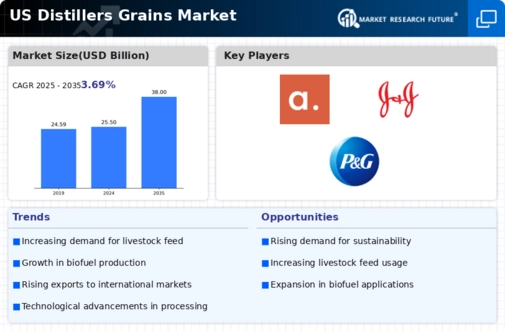Rising Ethanol Production
The distillers grains market is closely linked to the ethanol production industry, which has seen a resurgence in recent years. In 2025, ethanol production in the United States is expected to reach around 16 billion gallons, leading to an increase in the availability of distillers grains as a byproduct. This relationship is crucial, as distillers grains serve as a valuable feed resource for livestock. The growth in ethanol production not only supports the distillers grains market but also contributes to the overall agricultural economy. As producers seek to maximize the utilization of corn and other feedstocks for ethanol, the distillers grains market is likely to thrive, providing essential nutrients to livestock while promoting sustainable agricultural practices.
Increasing Livestock Production
The distillers grains market is experiencing growth due to the rising livestock production in the United States. As the demand for meat, dairy, and eggs continues to escalate, livestock producers are seeking cost-effective and nutritious feed options. Distillers grains, a byproduct of ethanol production, provide a high-protein alternative that supports animal growth and health. In 2025, the livestock sector is projected to expand by approximately 2.5%, further driving the need for distillers grains. This trend indicates a robust market for distillers grains, as producers increasingly incorporate these feed ingredients to enhance the nutritional profile of their livestock diets. The distillers grains market is thus positioned to benefit from this upward trajectory in livestock production, as it aligns with the industry's focus on sustainable and efficient feeding practices.
Cost-Effectiveness of Distillers Grains
The economic advantages of using distillers grains in livestock feed are becoming increasingly apparent. With feed costs representing a significant portion of livestock production expenses, the distillers grains market offers a cost-effective alternative. In 2025, the price of distillers grains is projected to remain competitive, potentially around $150 per ton, compared to traditional feed sources. This affordability, combined with the high nutritional value of distillers grains, makes them an attractive option for livestock producers. The distillers grains market is thus likely to see heightened demand as producers look to optimize their feed rations while managing costs. This trend underscores the importance of distillers grains in enhancing the profitability of livestock operations across the United States.
Sustainability Initiatives in Agriculture
The distillers grains market is benefiting from the broader sustainability initiatives within the agricultural sector. As consumers increasingly demand sustainably produced food, livestock producers are under pressure to adopt environmentally friendly practices. Distillers grains, being a byproduct of ethanol production, contribute to waste reduction and resource efficiency. In 2025, the emphasis on sustainable agriculture is expected to intensify, with many producers looking to incorporate distillers grains into their feed strategies. This trend aligns with the goals of reducing the carbon footprint of livestock production. The distillers grains market is thus likely to see growth as it supports the transition towards more sustainable agricultural practices, appealing to both producers and consumers who prioritize environmental responsibility.
Nutritional Superiority of Distillers Grains
The nutritional profile of distillers grains is gaining recognition among livestock producers, contributing to the growth of the distillers grains market. Rich in protein, fiber, and essential nutrients, distillers grains are increasingly viewed as a superior feed option. In 2025, the market is expected to witness a shift as more producers incorporate distillers grains into their feeding programs, recognizing their benefits for animal health and productivity. This trend is particularly relevant in the context of the growing emphasis on animal welfare and performance. The distillers grains market is thus poised to capitalize on this shift, as producers seek to enhance the quality of their livestock feed while ensuring optimal growth and health outcomes.














Leave a Comment